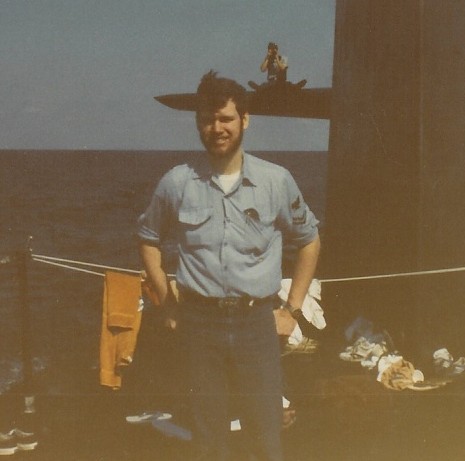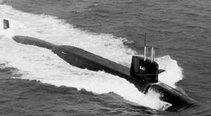Monday, October 03, 2005
When a political blog does ocean science – you get?
Well, read through this The Huffington Post post's comments about Fabien Cousteau's new method to study Great White Sharks. Lesbianism, bible humping, Dick Cheney, President Bush and terrorists all rolled into one.
Some days even googling a science topic gets you foul mouthed political noise. Smells like rotting fish, time to Move On. (Pun intended)
FYI, here is a link to a news piece on Fabien Cousteau's new submersible.
Friday, September 30, 2005
Aussie Submarine Rescue System - Deficient

Australian Collins Class Submarine (Source: Australian Navy)
The Australian Navy uses the Remora (Remotely Operated Rescue Vehicle) system for submarine rescue. The Remora system is a product of Ocean Works International of North Vancouver, BC Canada. The company has a good streaming video link promo of the system.
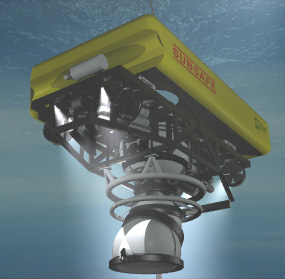
Remora Submarine Rescue System (Source: Australian Navy)
The Remora system seems a very capable submarine rescue system with the following specs:
Operational up to Sea State 4/5 transportable up to sea state 6+
Submerged depth up to 2000 ft
17 to 24 hours life support
Articulated mating skirt capable of up to 45 degrees mating lock
Transportable on C130 or larger military airlift aircraft
Can accommodate 2 crew + 16 passengers per rescue assent
The Australian Navy also has a comprehensive training program on submarine escape and rescue.
So you would conclude that the Australian Navy had a world class submarine rescue system. But seems that isn't so, the news site The Weekend Australian is reporting in an article Sub rescue unit 'a risk to lives' that there are significant problems with the AU Navy's submarine rescue program and equipment. As follows:
The navy's submarine rescue unit is in disarray, with faulty and obsolete equipment and poor training creating "intolerable" risks to sailors stranded under the ocean, according to a damning internal defence report.
A Review of Submarine Escape and Rescue Services documents a litany of frightening shortcomings that raise grave doubts about the navy's ability to rescue sailors from a stricken submarine.
The report, written in February, comes as the navy is seeking new hoses for its six Collins-class submarines to prevent a repeat of the catastrophic onboard flood that almost sank HMAS Dechaineux and its 55 crew in 2003.
The report, obtained by The Weekend Australian under Freedom of Information laws after an appeal to the Administrative Appeals Tribunal, concludes that the navy's submarine rescue system suffers from "a significant number of high risks".
Other specific problems cited in the AU Navy's report were a lack of spare parts for critical rescue equipment and a significant risk to the availability of cargo aircraft for Remora systems transport. Additionally training deficiencies may be a problem that could lead to equipment damage and failure.
In my opinion The Weekend Australian article goes a little overboard when it uses quotes that could have come from any submarine sailor in the world. An example:
"We always joke that escape systems are there for politicians and girlfriends," one submariner told The Weekend Australian.
"For the most part, the waters we operate in are too deep for rescue, and if an accident were to occur you would not be recovering anyone or anything. You'll just know where we went down."
Although the above two quotes are true for all who go to sea on submarines, it also true that it gets the public's attention when it appears a government is deliberately putting their sailors at risk.
With the HMAS Dechaineux flooding investigation the Assies have identified their problems and will fix their boats and systems. Therefore, they will continue to be one of the most capable submarine forces in the world.
Update 10/1/05: If you want to read back about the HMAS Dechaineux flooding incident Bubblehead at "The Stupid Shall Be Punished" has written a number of posts search link here.
Wednesday, September 28, 2005
Live Webcast of an Ocean Floor Exploration
The broadcasts will be of the Juan de Fuca Ridge seafloor 200 miles off the Washington coast an area known to be one of the most geologically and biologically active sites in the global network of mid-ocean ridges.

The Ocean Floor (Source: NASA graphic)
The broadcasts are part of a five-week expedition funded in part by the National Science Foundation, W.M. Keck Foundation and the University of Washington. Used in the expedition are the remotely controlled submersibles JASON II and ABE from the Woods Hole Oceanographic Institution.
The expedition is referred to as VISION 05, for Visually Integrated Science for Interactive Ocean Networked Systems. It's purpose is to study of how tectonic plate interaction can support exotic and ancient microbial life forms deep within the seafloor.
Tuesday, September 27, 2005
Architeuthis Filmed at Depth

The submarine Nautilus attacked by a giant squid in Jules Verne's novel 20,000 Leagues Under the Sea .
Japanese scientists, Tsunemi Kubodera and Kyoichi Mori, report that they have made the world's first observations of a giant squid in the wild. The researchers followed sperm whales, that are known to feed on giant squid, to find a location for their attempted filming. A system of a robotic cameras tethered to buoys and baited with a bags of mashed shrimp were used.
At about 3000 feet and positioned about 1,000 feet above the seafloor lowest bait on the rig attracted a small Architeuthis measuring 26 feet in length. It is believed that the giant squid can grow as large as 60 feet.
Attracted by the bait the Architeuthis got caught in the bait and camera rig. The robotic camera then took pictures every 30 seconds of the giant squid for over 4 hours as it struggled to free itself.
Although Jules Verne's Captain Nemo encounter with Architeuthis was a work of fiction occasionally deep sea submersibles have run across the unexpected.
On December 20, 2001 NOAA scientists aboard the submersible Alvin encountered a 21-foot-long squid, dubbed the "Mystery Squid," while conducting an undersea project.
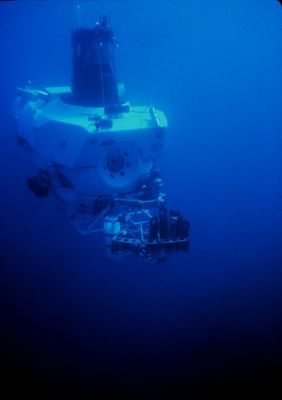
The Submersible Alvin (Source: NOAA)
The scientists were investigating gas hydrates in the Gulf of Mexico at a depth of approximately 6,300 feet below the surface when a 21 foot "Mystery Squid" drifted close to the submersible. The squid was captured on video before moving away after a few minutes.
NOAA scientists in 2001 could not be certain of the identity of the squid they encountered without capturing a specimen. The Japanese scientists who filmed the Architeuthis were fortunate in that a piece of the squid's tentacles was left behind after it escaped it's 4 hour entanglement. DNA analysis of that sample and other comparisons with squid that have washed ashore confirmed that it was an Architeuthis or Giant Squid.
For more information on Architeuthis go to the links page on The Search for Giant Squid webpage from a Smithsonian National Museum of Natural History 1999 exhibition.
Sunday, September 25, 2005
NUWC - Submarine Engineering Support Contracts Awarded

Virginia Class (Source: US Navy graphic)
GRYPHON TECHNOLOGIES in Riverdale, MD won a $44.7M contract to provide Submarine Non Propulsion Electronic Systems Programs Engineering, Life-Cycle, and In-Service Support.
ENGINEERING SERVICES NETWORK, INC. in Arlington, VA received a $42 million in NUWC support contracts.
RAYTHEON CO in Marlborough, MA received a $14.5 to $25 million contract for design, development, test and production work for X-band Extremely High Frequency (EHF) submarine communications.
The Naval Undersea Warfare Center, NUWC was once called the Naval Underwater Systems Center (NUSC) and before that Naval Underwater Research and Engineering Station.
NUWC, Newport RI falls under NAVSEA command and is the Navy's full-spectrum research, development, test and evaluation, engineering and fleet support center for submarines, autonomous underwater systems, and offensive and defensive weapons systems associated with undersea warfare.
Thursday, September 22, 2005
Raging Rita
GOES-12 Satellite infrared image provided by the U.S. Naval Research Laboratory, Monterey, Calif.

GOES-12 Satellite infrared image (Source: US Navy)
Infrared image shows the population centers with a very well defined Hurricane Rita. Navy assets are being redeployed to respond to this one two punch on the gulf coast. A number of Navy ships already in the gulf coast area put to sea to avoid the storm and be in position for assistance.
These ships include:
USS Iwo Jima (LHD 7)
USS Shreveport (LPD 12)
USS Tortuga (LSD 46)
USNS Patuxent (T-AO 201)
USNS Comfort (T-AH 20)
Additionally the Navy Region Northeast continues to provide assistance from Naval Submarine Base New London, Portsmouth Naval Shipyard and other commands for the Hurricane Katrina relief effort.
Help all those effected by supporting the American Red Cross.
Updated 9/23/05 - 13:00 Of related local RI interest I'd like to share. This is from a email forwarded to me by a recently retired RI National Guard member.
This was written by the XO of the USS Iwo Jima just before the MPs left New Orleans.
Finally, a word about our guests onboard, the 119th Military Police Company, Rhode Island National Guard.
These folks are headed home after a very long two weeks. To their credit, they were the first to enter the Convention Center and restore order with only 140 troops, though the mission called for more than 500. They saved 15 lives and evacuated hundreds.
The Company averaged more than 20 missions per day that lasted from 0600 until well past midnight on most days. I had an opportunity to accompany them on two missions and found them to be extremely professional - since they were among the first to arrive after Katrina, they became the resident experts for mission planning and execution for many other Guard and Army units. Their company even found time to care for 4 stray canines to relieve the stress.
Footnote: most of the MP Company returned from a tour in Iraq n April. Huge Heroes from a Small State.
Burton C. Quist
Colonel, US Marine Corps
Another RI National Guard MP unit from Warwick RI was one of the first units to serve at Gitmo after the start of the GWOT.
www.riguard.com
Saddle Up! Tonight We Ride!
See You On The High Ground!
Wednesday, September 21, 2005
Video file footage of Russian Submarine Force
How about the inside of an operational sub complete with Russian sailors looking like "What is he doing with a camera" look on their faces?
The Russian website www.tvdata.ru has a catalogue of short (a few seconds) file clips covering the Russian Navy submarines link here. Some footage was filmed from a helicopter and others are interior views of submarine equipment. The films are from independent producers & studios. They are for sale for commercial use on the website, but I found that if you click on the image you can run a short clip with a TVDATA watermark that's not that annoying.
(Warning: links best with Broadband)
Some of my favorites - with suggested titles:
SLBM zero defects? oops back to QA. link here
On the tail of a Typhoon. link here.
Always refer to the chart before wandering around the boat. link here
Rig for visitors, or Someone left the security covers off. link here
I think I see a periscope astern better clear baffles to make sure. link here
I'm thinking the guys at Defense Intelligence Agency (DIA) about 20 years ago would have loved to have seen this stuff. Back then, they were commissioning paintings like the one below of Soviet Typhoons.
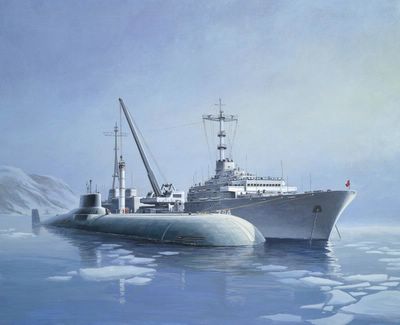
TYPHOON Replenishing in the Arctic by Edward L. Cooper, 1986
(Source: DIA Military Art Collection The Threat in the 1980's)
One last one: Midrats taste like chicken....meow. link here
Monday, September 19, 2005
Trident I (C4) Missile System Retired
A ceremony held on Sept. 7, 2005 marked the Change of Command for the USS Alabama SSBN 731, combining of crews and the retirement of the Blue Crew CO Cmdr. Kevin A. Fontes. It also marked the last Trident submarine scheduled for shipyard conversion to the Trident II (D5) missile system.
The USS Alabama Gold Crew was also awarded the Chief of Naval Operations (CNO) Afloat Safety Award on Sept. 2 after the completion of the Sub's historic 67th deterrent patrol and the last operational deployment of the Trident I (C4) missile system.

First Test Launch of Trident I (C4) Missile Jan. 18, 1977
(Source: DOD File Photo)
The C4 missile system, at 26 years, was the longest deployed US SLBM entering service in 1979 and being retired this year. The Missile was first back fitted to 12 Poseidon submarines and later the first 8 Tridents. The USS Francis Scott Key (SSBN-657) was the first submarine to successfully launch a C4 missile in July 1979. In October that year, SSBN-657 became the first submarine to go on patrol with the Trident I C-4.
The Trident I C4 missile was developed primarily a weapon of deterrence, adhering to Secretary of Defense Robert S. McNamara's Mutual Assured Destruction or MAD doctrine. The missile had an estimated range of 4000 nm nearly double it's predecessor but lacked the ability to effectively target hardened enemy ICBM missile silos.
The current Trident II (D5) missile is the culmination of Secretary of Defense James Schlesinger's concept of counterforce as deterrence. Entering service in 1990 the D5 missile could be considered a first strike weapon when measured against the improvement in accuracy and range over it's predecessor the C4. However, under the counterforce as deterrent doctrine the targeting of enemy's strategic weapons systems would only be used an immediate retaliatory response and for a first strike.
It seemed only fitting to post the news on this planned obsolescence of the C4 weapons system. I served on one of the first subs USS Simon Bolivar (SSBN 641) and the very last USS Alabama (SSBN 731) the last to carry that system to sea.
Update: 9/21/05 - 13:00 From a reader of TheSubReport "The conversion of the Alabama to D5 Backfit also marks the end of the SINS based navigation system. This system has been supporting the Strategic Weapons System since the Polaris days, almost 50 years."
Almost 50 years longevity is a remarkable achievement for a system as complex as the SINS -Ships Inertial Navigation System. SINS was created out of the joint Army/Navy JUPITER program then further developed to support the POLARIS program. Although a Regulus guided missile submarine, the USS Halibut (SSGN 587) was the first submarine to carry the Ships Inertial Navigation System (SINS) back in 1960.
Thursday, September 15, 2005
Cocaine Submarine Force Reduction
BOGOTA, Colombia -- The U.S. Coast Guard, acting on Colombian intelligence, intercepted a ship towing an unmanned submarine-like vessel that held more than 2 tons of cocaine, Colombia's anti-narcotics police chief said Thursday.
The boat was raided Wednesday off the coast of the Ecuadorean-owned Galapagos Islands, Gen. Alberto Gomez told reporters. The underwater capsule, which was attached by a metal cable, was designed so smugglers could tow it below their boat and escape detection if drug agents searched the ship.
Of course this isn't the first attempt to construct and use a submarine type vessel to smuggle drugs. Just last March Colombia's secret police discovered a nearly complete fiberglass submarine (CBS news) designed to carry cocaine to speed boats offshore.
Then there was the September 2000 discovery of a half-built submarine in a warehouse in Bogota, Remember that one?

Cocaine Submarine Under Construction Sept 2000.
The BBC reported the submarine under construction back in 2000 as being sophisticated and based on a Russian design. It was speculated that the Russian mafia or Russian technicians were involved in its construction.
So here's the tally:
1) The Russian designed large Sub was found in 2000 half way through construction.
2) The fiberglass Sub found in March of this year was nearly complete.
3) And now the drug smugglers have had a nearly successful sea trail of a towed UUV variant.
What's next?
Thursday, September 08, 2005
I Feel The Need, The Need for Speed!
It must have been this fascination with complex machines that do extraordinary things that brought me to submarines and if my life choices had been a little different I may have earned Wings instead of Dolphins.
That being said I felt the need to share some aviation eye candy.
Scroll down and fulfill your "Need for Speed" complete with trans-sonic vapor clouds.
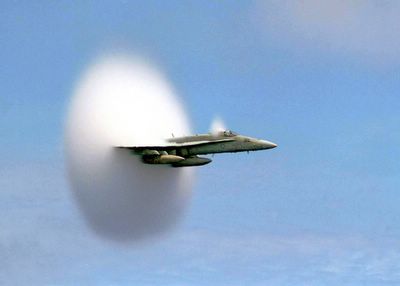
F/A-18 Hornet going Supersonic Location Taehan-min'guk – Republic of Korea, July 7, 1999
(Source: US Navy -Ensign John Gay)

F/A-18F Super Hornet July 27, 2005 USS Kitty Hawk (CV 63) Philippine Sea
(Source: US Navy - Photographer's Mate 3rd Class Jonathan Chandler)

F/A 18 going Supersonic (Source: US Navy)

F-14B Tomcat USS Harry S. Truman (CVN 75) Mediterranean Sea Mar. 30, 2005
(Source: US Navy -Photographer's Mate 3rd Class Justin S. Osborne )

F14-B Tomcat going Supersonic Mediterranean Sea, April 22, 2003
(Source: US Navy - Justin S. Osborne)

B-1B subsonic but super low (Source: USAF)

STS-106 Space Shuttle Atlantis, September 8, 2000 going Trans-sonic
(Source: NASA)
OK, if the photos weren't enough to satisfy, then you may want to try this (I did) or this or maybe even this.
Monday, September 05, 2005
Alligator Hunting
The National Oceanic and Atmospheric Administration NOAA and the Office of Naval Research ONR have teamed up to search for the civil war submarine USS Alligator. This is the second year for this NOAA-ONR collaborative effort schedule to resume Sept. 9-12 off Cape Hatteras, N.C.
The newsobserver.com has a short article on this current effort.
The USS Alligator (Source: NOAA - Painting by Jim Christley)
The Alligator was so named because of it's low profile and distinctive green color. The 47 foot long sub was lost in April of 1863 while being towed by the USS Sumpter. The Sumpter was to tow the Alligator from Virginia to Charleston S.C. to participate in Union attacks on that Confederate port. The sub sank in a fierce storm somewhere south of Cape Hatteras and Ocracoke Island, N.C. in an area known as the “Graveyard of the Atlantic”. In a heavy gale and no crew aboard the USS Alligator the captain of the USS Sumpter unable to make headway cut the tow line.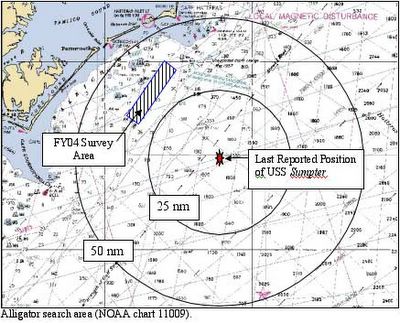
Hunting the Alligator (Source: NOAA)
An initial side-scan sonar search by the NOAA Ship Thomas Jefferson in the spring of 2005 identified several new targets. Additional investigation of these targets will be conducted using marine magnetometer and a remotely operated vehicle (ROV). Operating out of Ocracoke, N.C., a team of marine archaeologists and researchers will work aboard ONR’s 108-ft. “Afloat Lab” (YP-679), deploying a number of these undersea search and survey tools.
The USS Alligator has a distinctive place in history which few are aware. It was the US Navy’s first submarine.
There is some confusion around the first US Navy submarine claim. David Bushnell’s The Turtle used in the revolutionary war in September 1775 was piloted by an Army Sergeant and volunteer and not commissioned by the Continental Navy/Marines. John Holland's Holland VI is many times incorrectly cited as the US Navy's first Submarine even though it came some 26 years after the USS Alligator.
The USS Alligator was an innovation in naval design at the time and included many features and firsts for a submarine:
First submarine ordered and built for the U.S. Navy
First submarine to have a diver’s lockout chamber.
Was deployed to a combat zone.
First submarine to have onboard air compressors for air renewal/diver support.
First submarine commanded by a U.S. Naval officer (who would later achieve Flag rank).
First submarine designed with an air purifying system.
Had an underway test witnessed by a U.S. president (Abraham Lincoln).
First submarine to have electrically-detonated limpet mines.
Underwent an overhaul in a U.S. naval shipyard.
If you're interested in the project to find the USS Alligator and the sub's history, more information can be found at the NOAA website (Link here) specifically devoted to this project.
Thursday, September 01, 2005
The Original Silent Ships
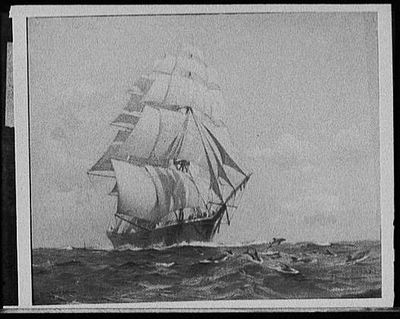
The Flying Cloud (Source: National Archives)
The Silent Ship by Colin West
I sailed a ship as white as snow,
As soft as clouds on high,
Tall was the mast, broad was the beam,
And safe and warm was I.
I stood astern my stately ship
And felt so grand and high,
To see the lesser ships give way
As I went gliding by.
That was the Golden Age of Clipper Ships romanticized in books and movies.
In another one hundred and fifty years will these be the new silent ships of legends?
(The Urban Legends link above is for my friends back in maneuvering ;-)
Saturday, August 27, 2005
Repel Boarders "The Video Game"
Therefore, the brain learns through pattern recognition and deduction, the more embedded the pattern the stronger the memory and the quicker and easier the response. Which brings us to shipboards drills, you remember those, reactor scram, fire in the galley, torpedo hot run, WSRT, etc. Now the Navy is putting a new twist to the Repel Boarders drill - practice it with a video game.
Navy SSN 688 class submarine crews will use a custom built video game to practice anti-terrorism tactics aboard ship. The company 3Dsolve developed what is called a Force Protection Anti-Terrorism Simulation Trainer, a three-dimensional, first person view, decision making game.
National Defense Magazine has an article you can read for the details on this new twist to a common shipboard drill.
When given access 3Dsolve animation developers said they were stunned by the complexity they found inside a SSN 688 class submarine. Only 688 class Subs at the Submarine Base in New London have had scenarios created but the Navy plans on a new version to include SSBN 726 class submarines and additional port scenarios.
In 1981 I would play Asteroids at the video arcade in Virginia Beach while at Dam Neck FBM “C” school. But, I never thought someday you could play something just short of DOOM3 for your watchstation quals, times have changed!
Wednesday, August 24, 2005
Brac - Clean Sweep!!!
The Brac Commission has voted to take the Submarine Base in New London and the Portsmouth Naval Shipyard off the list of base and facility closures.
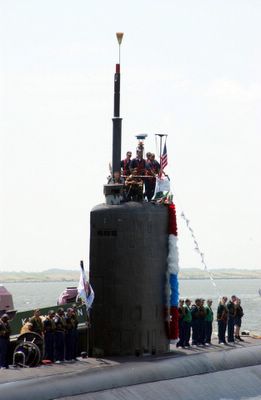
Clean Sweep (Source: US Navy via navsource.org)
Photo is from the USS Montpelier (SSN-765) preparing to moor at Naval Station Norfolk. I choose this Photo as a little poetic justice on my part. Now I wonder if any Subs will end up moving from Norfolk to Groton, only time will tell.
Sunday, August 21, 2005
We Build the Best -Submarines
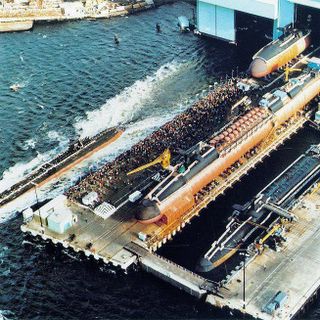
General Dynamics Electric Boat (Source: US Navy Photo)
The last 688, a 688i variant, SSN 773 the USS Cheyenne was delivered to the Navy in September 1996 by NNS. Since then EB has delivered three SSN 21 Seawolf class submarines, was the lead designer of the new Virginia class submarine and delivered the SSN 774 USS Virginia in October of 2004. Newport News has not built another submarine since 1996 until the recent launch of the USS Texas SSN 775 in April of 2005. Newport News Shipbuilding also produces the best Aircraft Carriers in the world, the Nimitz class, of which nine have been built and one is currently in construction.
Therefore, who builds a better submarine General Dynamics Electric Boat or Northrop Grumman Newport News Shipbuilding? I was qualified on and rode two different boats, one built by NNS in 1965 and another built by EB in 1985. Not a fair comparison two different classes with 20 years difference in technology and design. And as I indicated before I was once a EB yardbird, so there is a built in bias here, fair warning in where I’m going with this.
Newport News has always built a quality submarine. The USS San Francisco SSN 711 built by NNS ran into a seamount at a full bell crushing it bow in January. The San Fran may not have survived if not for the quality of its construction and professionalism of the crew. But if being the “Best” means also staying on budget and delivering when contracted to then Newport News get a losing grade. NNS will not deliver the USS Texas to the Navy until May 2006 almost a year after the initial projected delivery date. Newport News Shipyard’s construction of the Texas is also an estimated 24 percent over projected cost.
Lead units are usually problematic and NNS will have had a nearly 10 year hiatus between deliveries of its last two submarines, but the Virginia class is different. In order to maintain two active submarine construction yards, production of the 10 projected Virginia class submarines is being split between EB and NNS with whole systems produced by one or the other. For example, EB will build the ships Command and Control Systems and NNS will build the Weapons Systems. Final submarine assembly will be split between each shipyard EB has completed the USS Virginia and NNS is in the process of completing the USS Texas. This is different from the 688 contracts where each yard did the bulk of its own component fabrication and construction.
Therefore, here is my argument, its not who builds thE Best submarine but who is the better shipyard at submarine construction? Both shipyards have had their share of cost overruns and problems and in the end both build a quality submarine. However, Electric Boat has an advantage in that its only business is in the design and construction of nuclear submarines for the US Navy. Newport News Shipyard builds submarines as well, but also produces Navy surface ships and has an extensive surface ship overhaul and conversion business. Additionally Electric Boat’s Quonset Point facility is dedicated to the quality fabrication of submarine pressure hull sections. In fact, a major portion of the pressure hull sections that NNS will use in the construction of Virginia Class subs will come from Electric Boat Quonset Point. Also recently the Navy has been concerned about NNS construction delays and cost overruns has asked EB to take a more active role as the lead design yard in managing Newport News Shipyard’s Virginia class submarine construction program.
With the current reduced production rate of submarines the Navy is hard pressed to keep two shipyards building submarines efficiently. Therefore, at 1.6 billion the Virginia class submarine was to be a cost saver for the Navy and far cheaper than the 2.8 – 3.0 billion Seawolf class, but the current Virginia class subs are now costing between 2.4 -2.7 billion a copy. With the current procurement rate of one submarine a year that cost could drop to just around 2.0 billion per hull if the build rate were increased to two subs per year. A side note two new subs a year would also keep our force level at it’s current state where as the one per year rate will further reduce the size of the SSN fleet as older 688s are decommissioned.
The Navy has some tough choices. In order to keep a two competitive shipyards producing submarines it must split what a single shipyard could handle easily between two yards. However, this decision comes at the expense of higher production costs. There is no economy of scale in production and smaller regional parts suppliers can no longer be supported by the effective reduction of orders. Additionally the shipyards are forced to retain higher cost engineers and trades people in order to maintain the required instructional skill sets while reducing their work force. These highly skilled shipyard workers end up back filling functions that are below their skill level or worse doing busy work thereby further driving up production costs.
Hopefully the Navy and the two remaining submarine manufactures EB and NNS can made this joint production competition/non-competition thing work. But if not and costs drive procurement rates down like the Seawolf class, from 29 hulls down to only 3 we could some day be saying that a foreign manufacture builds the “Best” submarines in the world.
Sunday, August 14, 2005
Submarines True Systems of “Transformation”
Consider the following questions:
Do submarines provide a valuable asset to the “Transformation” of the American military into a network-centric fighting force or are they just inflexible relics of the Cold War and 20th century?
What is today’s force level requirement for Submarines? Do we need the Cold War level of roughly 100 SSNs or should we let the submarine force draw down to about 30 boats?
Capt. James H. Patton Jr. USN (Ret.), president of Submarine Tactics and Technology, Inc. and former member of the Naval War College faculty addresses the above questions in a recent Newport Naval War College linked white paper “THE SUBMARINE AS A CASE STUDY IN TRANSFORMATION – Implications for Future Investment.” I recommend reading the entire paper, about five pages, but I've also provided a summary and some thoughts below.
TRANSFORMATION
Mr. Patton’s paper outlines the evolution of the submarine from 1900 to present providing examples of submarine designs adapting to unforeseen requirements. Part of that evolution:
S-Boats designed in the 1920s for coastal defense and fleet boats designed in the 1930s as battle-fleet scouts found themselves in 1942 as distantly deployed commerce raiders.
The Skipjack class, designed to provide terminal guidance for nuclear-tipped Regulus cruise missiles fired from a large fleet of Halibut-class SSGNs, never materialized because of the advent of the Polaris ballistic missile.
The Thresher/Permit-class SSNs, designed to operate in pairs while firing rocket-propelled nuclear depth charges at distant Soviet subs, never carried out that mission, due to the failure of Sesco, a secure acoustic communications system needed for information exchange and the triangulation of sonar bearings for target localization.
Escorting carrier battle groups was the justification for the high speed of the Los Angeles class in the late 1960s. Even though submarines were used in direct support of battle groups in a 1977 Pacific Fleet exercise (RimPac), and a Navy warfare publication was published in 1980 based on further experimentation in RimPacs 1978 and 1979, this mission was not routinely assigned until after the Cold War ended, when many of the class were being decommissioned.
With the above examples and others, Mr. Patton presents an argument in that “To avoid obsolescence, it was sometimes necessary for extreme variant requirements to be made technically (and tactically) during a ship’s (and crew’s) lifetime. As a result it can be safely said that no U.S. submarine has ever been employed for its designed purpose, and no commanding officer ever performed that for which he was trained.” The only exception I would make is that of SSBN Fleet Ballistic Missile submarines who's purpose of nuclear deterrence has not changed since the 1960s only the targeting packages.
But then again, excess 726 Class SSBN capacity post the Cold War has resulted in four Tridents scheduled for conversion to the new Ohio Class SSGN. This will result in adapting a submarine platform from its initial design of nuclear deterrence to one of an Information Systems Research (ISR) intelligence processing node and Special Operation Forces (SOF) platform with land strike capability. A truly network-centric warfare system as Mr. Patton qualifies with using the Giant Shadow and Silent Hammer counterterrorism exercises as examples.

USS Virginia (Source: US Navy)
Another point made in the white paper is this:
“It should also be clear, to those who think deeply about such matters, that the SSGN program is far more than just a way to extend the operational viability of declining SSBNs; it is a pilot program to investigate just what the Virginia class should become when it has fully evolved in ten years.”
Essentially the Ohio SSGN program is a proving ground for technologies and tactics that well evolve and be incorporated into the new Virginia class submarines.
FORCE LEVEL
The latter part of the Mr Patton's paper briefly addresses the number of submarines we will require for our furture submarine force "Force-Level" with this.
However, with the world situation becoming increasingly unstable, there are more than one or two places where a credible, actual, or virtual U.S. presence must be claimed or maintained. Therefore, to sustain persistently unseen assets around the world, there is a force-level number that must be maintained. This number is significantly more than thirty, the level resulting from a one-per-year build rate of thirty three-year-design-life hulls, when operating tempos, maintenance, and transits are factored in. All post–Cold War submarine force level studies by several agencies indicate an enduring need for numbers of SSNs far in excess of what can be sustained by a one-per-year build rate.
I think what unstable areas Mr. Patton alludes to is obviously the Middle East and Western Pacific. But without long forward deployments a SSN force of 30 hulls, with some in the shipyard some deployed for carrier taskforce ASW protection and some in port, the Navy would be hard pressed to “sustain persistently unseen assets around the world”.
It is stated in the paper that "SSN taskings by fleet and national commanders have essentially doubled since the end of the Cold War" even though the force level of SSNs has dropped from 100 to roughly 50 today. The predicted affect is: “Because of this submarine shortage, existing ships must now transit at much higher sustained speeds than originally planned, which threatens the life span of their reactors.” If this is true then SSNs would be heading to the shipyard sooner for refueling thereby putting addition pressure on our existing submarine assets.
Conclusion
To me all the above (Submarine systems adaptability and increased force requirements and tasking) seems to run counter to the current DOD and Navy decisions with regards to the New London Sub Base being on the Brac list and the reduced build rate for the Virginia class Subs. My concern is that the powers that be (budgetary and political) may indeed hurt Submarine Force and lessen this country’s ability to defend itself.
Thursday, August 11, 2005
Film of the Shot of the Day

Operation Crossroads Baker Shot (Source: DOE)
I ran across some film of the Operation Crossroads Baker shot (National Geographic HERE or the DOE HERE) that resulted in the test target USS Pilotfish, moored at a depth of 168 feet and at a range of 363 yards from the point of the blast, in sinking. Only 21 of the 71 ships in the Able and Baker tests actually sank but all sustained damage. If not sunk during the tests the remaining ships were heavily contaminated with radiation and were either scuttled, sunk in gunnery exercises or scrapped.
The Baker shot was a 21-kiloton shallow water test detonated some ninety feet underwater and was the final weapon test conducted as part of the original Manhattan Project.
Monday, August 08, 2005
My Russian Watch is Broken

Hey, I thought it looked cool anyway and I needed a watch at the time. Live and learn, the watch's winding stem fell off two months ago. I've changed country and service branch since, my new watch is a Swiss Army.
Therefore, when I saw this headline "Navy team given Russian wristwatches for sub rescue" (Hat tip: TheSubReport) My first thought was, I hope they get something of better quality, followed by Vika's recommendation "Don't get it wet" which I'm thinking could also apply to the current state of the Russian Navy.
Sunday, August 07, 2005
I was Four Striper for Four Minutes Today
The restoration work is dirty so I wear steel toe work boots, old blue jeans, a tee shirt, ball cap and safety glasses. The manager of the Juliett has asked the Subvets that volunteer to wear something to add color to the tours. Some of the docents wear Russian seaman shirts and hats. I’ve been doing maintenance work so I wear a tee shirt and ball cap with silver dolphins and saying simply “US Submarine Force – Silent Service”. My real job has me at a computer all day so getting down in the bilges, so to speak, and using a wire brush and scrapper feels good (as long as its my idea) and telling a sea story to a passing inquisitive tourist is, well, sort of like blogging in person. But I digress….
I had been working for about two hours and was getting hot so I got my can of ginger ale and went topside. One of the Russian subs watch standers (employee) was busy bringing up folding chairs from below decks for a Senior Chief Sonarmen’s retirement ceremony. With only one person from the Juliett doing the setup I stepped in to assist. Because of the number of the attendees 30-40 with some elderly or in a wheelchair we decided to set things up on the pier verses the Juliett’s missile deck. Within 45 minutes, everything was setup and ready to go chairs, podium, Colors, big quarterdeck shells and sideboys complete with bosun’s pipe. OK, back below for this civilian to continue my bilge therapy session.
Not so fast, time for a quick rehearsal and they need someone to fill in and be piped aboard. So yours truly is enlisted once again, this time as a couple of COMSUB or SUBRON somethings (Squadron Twelve was one I think, sorry didn’t pay attention). Must have been a site, me looking like an A-Gang striker covered head to foot in Russian pigboat dirt, being piped aboard with sideboys and all, had a little chuckle to myself.
Ceremony looked like it went off without a hitch.
Best of luck Senior Chief and thanks for your service.
Bad Air and AS-28 Submersible Rescue
"We must complete the operation in 24 hours because the supply of air on board is not without limit," Interfax news agency quoted the deputy chief of navy staff, Vladimir Pepelyaev, as saying.
"It is believed that there is still enough air for slightly more than 24 hours," Pepelyaev added. Initial offical reports said the AS-28, itself a rescue vessel, ran into trouble when its propeller became entangled in fishing nets during a military exercise. They said it had five days' supply of air -- more than enough for any rescue mission.
However, about 1100 BST on Friday, naval spokesman Igor Dygalo said the trapped vessel had only 24 hours' worth of air left. There was no official explanation why estimates of air remaining still stood at 24 hours on Saturday morning.
This submersible was primarily submarine rescue vehicle and therefore the crew would have been trained in all aspects of submarine rescue problems, including air quality and conservation. Once the crew knew that they needed to await outside rescue that training would have kicked in and may have been what pushed the air supply to the more optimistic estimates.
If my experience with doing restoration work on the old Soviet Juliett 484 is any indication the Russians kept an ample supply of lithium hydroxide for CO2 absorption. They may also have kept chlorite candles chemically similar to what is in an OBA for emergency O2 generation on board their submarines. It would be reasonable to think that this practice would include a submarine rescue submersible if not for its own use then to supplement a submarine on the bottom. Any submarine rescue vehicle would require multiple trips to a stricken submarine to effect a complete crew rescue.
As far as the political air is concerned, Putin and some Russian admirals can get some sleep tonight. It would have been a political crisis similar to that of the Kursk if things had come out differently, for the sake of the AS-28 crew, thank god and the Brits ROV team it didn't.
